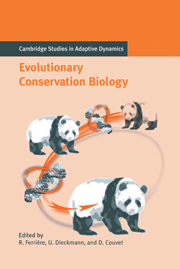Book contents
- Frontmatter
- Contents
- Contributing Authors
- Acknowledgments
- Notational Standards
- 1 Introduction
- Part A Theory of Extinction
- Part B The Pace of Adaptive Responses to Environmental Change
- Part C Genetic and Ecological Bases of Adaptive Responses
- 9 Fixation of New Mutations in Small Populations
- 10 Quantitative-Genetic Models and Changing Environments
- 11 Adaptive Dynamics and Evolving Biodiversity
- Part D Spatial Structure
- Part E Community Structure
- References
- Index
- The International Institute for Applied Systems Analysis
10 - Quantitative-Genetic Models and Changing Environments
Published online by Cambridge University Press: 15 August 2009
- Frontmatter
- Contents
- Contributing Authors
- Acknowledgments
- Notational Standards
- 1 Introduction
- Part A Theory of Extinction
- Part B The Pace of Adaptive Responses to Environmental Change
- Part C Genetic and Ecological Bases of Adaptive Responses
- 9 Fixation of New Mutations in Small Populations
- 10 Quantitative-Genetic Models and Changing Environments
- 11 Adaptive Dynamics and Evolving Biodiversity
- Part D Spatial Structure
- Part E Community Structure
- References
- Index
- The International Institute for Applied Systems Analysis
Summary
Introduction
Mutation is the ultimate source of genetic variability. However, a large fraction of mutations reduce the fitness of the individuals in which they occur (Chapter 7). The evolutionary consequences of mutations with an unconditionally deleterious effect are manifold and have been the subject of intense investigation (Charlesworth and Charlesworth 1998; Chapter 9). Since many mutations affect several traits and the developmental pathways are complex, their fitness effects may also depend on the genetic background in which they occur, and on the kind of selective pressure to which the population is exposed. For instance, if for a given trait, say birth weight, there is an optimal phenotype, a mutation that increases birth weight will be detrimental if it arises in a genotype that, otherwise, would have the optimal or a higher birth weight, but will be beneficial in other genotypes. In a changing environment, the selective value of an allele will change with time if different values of a trait affected by the allele are favored at different times. The fitness effect of a given mutation, therefore, depends on the effect it has on this trait, and on the current environment. Hence, a newly introduced allele may, in spite of its immediate adversary effect on fitness, prove to be beneficial at a later stage of the population history. Mutation itself thereby gains an additional role as a provider of the genetic variation that allows adaptation to occur.
- Type
- Chapter
- Information
- Evolutionary Conservation Biology , pp. 171 - 187Publisher: Cambridge University PressPrint publication year: 2004
- 27
- Cited by



